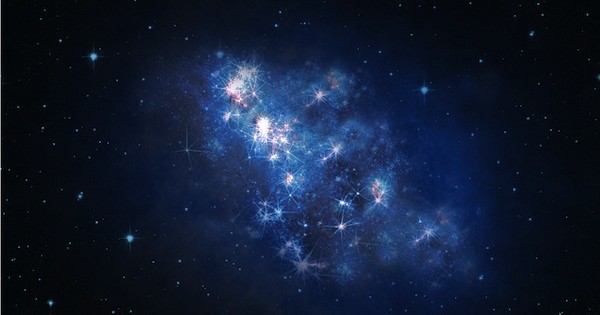
Some days when I read of a discovery I feel very, very, small—a smidgen, a fleck of dust, or a nanoparticle. Today is one of those days. Astronomer Steven Finkelstein of the University of Texas at Austin and his team have discovered the earliest and furthest galaxy in the universe—a star-gusher that was born just 700 million years after the Big Bang.
That means that the galaxy—named, prosaically, z8_GND_5296, or Sybil, as I just now nicknamed it, was formed when the universe “was only five percent of its current age of 13.8 billion years,” according to Casey Papovich of Texas A&M University, who coauthored an article with Finkelstein in the October 24 issue of the journal Nature. In other words, Sybil is a mere infant. It is so far away that its light has taken about 13.1 billion years to reach Earth and be detected.
Because the universe is expanding constantly, the greater the distance a galaxy from Earth, the earlier it had come into being. But as the galaxy moves farther away, the wavelength of the light it emits increases or is “stretched” toward the red end of the spectrum, a phenomenon known as “redshift.” Finkelstein, Papovich, and their colleagues used one of the world’s largest earthbound infrared telescopes—Keck Observatory’s Keck I, which is perched on the summit of the dormant Mauna Kea volcano in Hawaii—to measure the galaxy’s redshift. Keck I is outfitted with a new, supersensitive instrument called MOSFIRE (Multi-Object Spectrometer for Infra-Red Exploration), which established its redshift at 7.51, the highest ever identified.
The galaxy itself is so young that it dates to one of the most momentous eras in cosmic history: the “re-ionization of neutral intergalactic hydrogen gas that filled space at these early epochs,” as Cornell University astronomer Dominik A. Riechers writes in an accompanying commentary in Nature. That massive change occurred when the first stars formed and began emitting strong ultraviolet light, which triggered the formation of positively charged hydrogen protons.While neutral hydrogen gas is opaque, its ionized state is translucent. It’s possible, Finkelstein says, that Sybil exists in a region of the universe previously ionized, which may have helped the astronomers detect it.
Finkelstein pronounces himself “thrilled” at the discovery of the galaxy, which is so active that it is giving birth to stars at a rate 150 times faster than our own Milky Way. As he wrote to me in an email, “I try to push the boundaries by pushing studies of galaxies as far back in time as possible, with the ultimate goal of finding the first galaxies to form after the Big Bang.” As for the galaxy’s exceptional rate of star formation—a rate of about 300 “solar masses” per year—“we think that it’s telling us that these highly star-forming galaxies are more common, which can give insights into how galaxies in the early universe turn their gas into stars.”
I find the galaxy’s existence, and the announcement of its presence, oddly reassuring. While I muddle through my everyday life, fretting over trivia, our friend Sybil’s stream of newborn stars are calmly but steadily beaming light across vast chasms of space and time. And that, for some reason, makes me feel happy.

